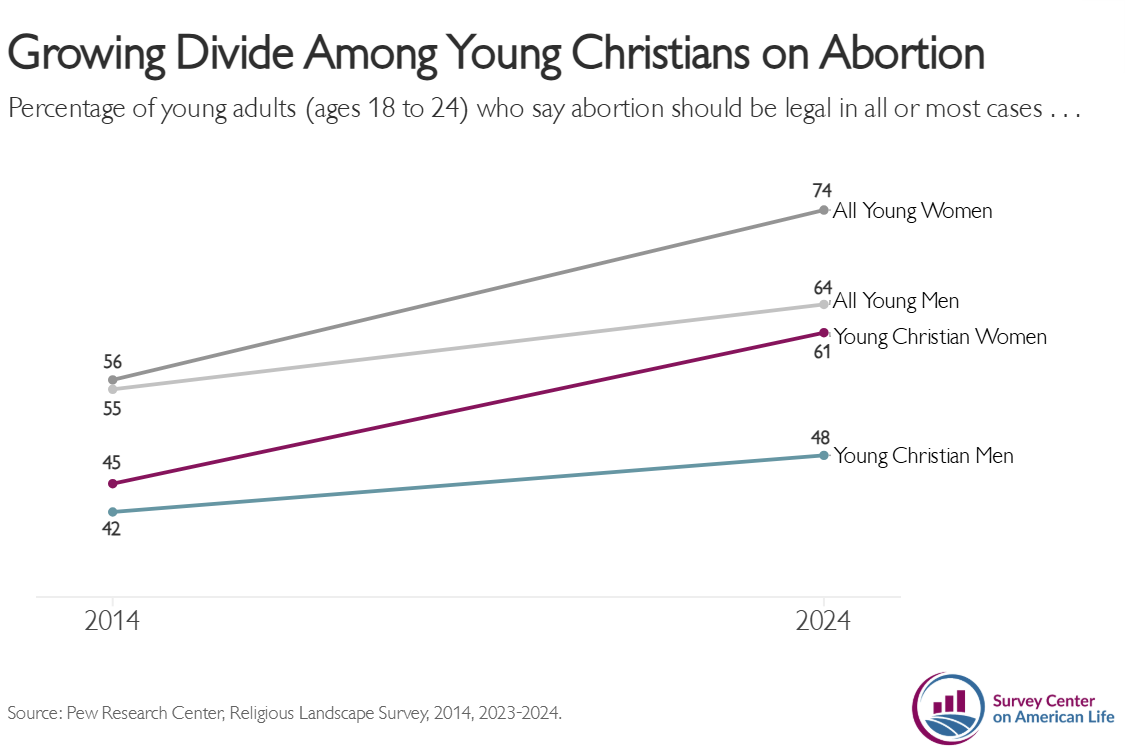Newsletter March 20, 2025
The Gender Gap in Church is Growing

This past weekend I participated in a panel discussion focused on Generation Z, the gender divide, and the political ramifications of the growing divergence between young men and women. At one point, the moderator asked a question I had never considered: “Is the gender divide less evident among young Christians?” On its face, the question seems very reasonable, and I said as much at the time. Although inter-denominational differences can be significant, many Christians share similar values that could potentially diminish the growing rift between young men and women. As it turns out, on many critical issues, young Christian men and women have decidedly different views. The gender gap in church is indeed growing.
A few weeks ago, the Pew Research Center released their 2024 Religious Landscape Survey (RLS)—likely the most authoritative source of information on the state of American religion. It’s a massive study based on nearly 37,000 interviews that includes questions covering religious identity, practices, beliefs, and change. It also includes a number of measures on political and social attitudes. Because of the considerable size of the survey and its focus on religion, it provides a unique opportunity to tackle this question.1
Let’s start with abortion. More than six in ten (61 percent) young Christian women say abortion should be legal in all or most cases. Less than half (48 percent) of young Christian men say the same. Young Christians are less supportive of legal abortion than their peers, but the drop off in support is substantially larger among men.
The gender gap is even wider in views about homosexuality. Three-quarters of young Christian women say that homosexuality should be accepted by society, a view shared by less than half (49 percent) of young Christian men. That’s a 26-point gap. Young Christian women are also far more likely than men to support allowing gay and lesbian people to marry (75 percent vs. 57 percent). A majority (54 percent) of young Christian women say greater acceptance of transgender people is a positive development, but only 29 percent of young Christian men agree.

There’s some indication the gender gap among young Christians has gotten larger.
A decade earlier, young Christian men and women were more aligned than they are today. In 2014, less than half of young Christian men (42 percent) and women (45 percent) said abortion should be legal in all or most cases. The gender gap in views of abortion has since quadrupled, with young Christian women becoming much more supportive of its legalization. This movement aligns with other surveys that show young women becoming increasingly supportive of abortion rights, especially after the Dobbs decision. Does this mean the growing gender divide among young Christians is due to young women moving left? Not so fast. When it comes to views on homosexuality the reverse is true. Young Christian women have hardly changed their views over the last decade, while young men have become less supportive.
If the cultural divide has grown, how do young Christians’ attitudes compare when it comes to economics and the role of government? Here too, young Christian women are more progressive than men, but both groups are well to the left of older Christians. Three-quarters of young Christian women would prefer a larger government offering more public services. Nearly six in ten young Christian men say the same. Support is lower among young men, but they are far more supportive of a generous and active government than older Christian men.
The Pew survey also shows double-digit divides in partisan affiliation and political ideology. Young Christian women are more than twice as likely as men to be liberal and substantially more likely to identify as a Democrat (15 percent versus 27 percent, respectively).
What might explain the divisions between young Christian women and men?
It’s not religion. Despite differences in cultural attitudes, there is not much evidence that young Christian men and women practice their faith any differently. They attend religious services at similar rates, say grace at meals, and participate in scripture reading or prayer groups about as often. Young Christian women are somewhat more likely than men to pray daily (47 percent vs. 38 percent, respectively). Their denominational makeup is also roughly similar. It’s not as if young Christian men are disproportionately evangelical or are more likely to belong to theologically conservative churches than women.
Rather, what seems likely is that young Christians are being exposed to the same cultural divides afflicting secular young people. Even if they attend the same church, the social context for young men and women is still quite different. Young Christian women have many more close friends who identify as LGBTQ than men, an experience that has a considerable influence on policy views. Social media habits may play a role as well. Social media algorithms increasingly segregate young women and men online; the content they are exposed to is often dramatically different, which may reinforce gender divisions. Finally, as marriage rates have fallen, even among Christians, there are fewer opportunities to learn more about the perspectives and experiences of the opposite sex in the context of a loving, trusting relationship. Louise Perry recently argued that the youth gender gap is better understood as a divide between single people. In many ways she’s right. The gender gap among single people dwarfs that among married couples.
Fewer young adults today are raised in religious communities, but clearly the lack of religious experience fails as an explanation for the growing cultural divide between young men and women. It’s possible that shared religious experiences may help young Christians bridge the gender divide, but it won’t erase it. Spending time in a religious or spiritual community, and participating in shared practices is an important way to foster understanding and reduce tensions. It’s not the only way to counteract the social and technological forces pushing men and women apart, but it’s a good place to start.
1 For this analysis, Christian is defined broadly to include the following groups: Protestants, Catholics, Orthodox Christians, Jehovah’s Witnesses, and Latter-Day Saints.
Read More on American Storylines









